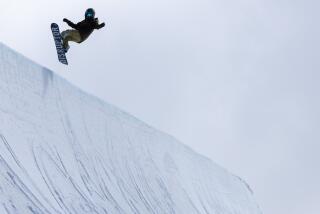Brain-Injury Researchers to Study Amusement Rides
- Share via
A national research and advocacy group will launch the first in-depth study into the possible link between brain injuries and thrill rides in response to increasing concerns over roller-coaster safety since recent deaths at two California amusement parks.
The Brain Injury Assn.--a nonprofit, nonpartisan group that focuses on brain injuries, prevention and education--will examine 30 to 50 cases in which amusement park patrons are alleged to have suffered brain injuries ranging from headaches to fatal ruptured aneurysms after riding a roller coaster or other attractions.
“If we can prevent one potential brain injury, that’s worth doing,” said Allen I. Bergman, the association’s president and CEO. “Brain injury is a silent epidemic. It is not on anybody’s radar screen. For us, this is an opportunity to see if there’s anything substantive here.”
But industry officials insist the rides are safe and that there is no medical evidence to suggest otherwise.
The issue attracted attention this summer when 28-year-old Pearl Santos of Fontana died after suffering a ruptured aneurysm on the Goliath roller coaster at Six Flags Magic Mountain in Valencia. Although many neurologists say that an aneurysm can burst at any time, the coroner’s report indicated that the stress and strain of the ride may have been a contributing factor in Santos’ death.
Last month, a 42-year-old woman died of a brain hemorrhage after riding a spinning attraction at Six Flags Marine World in Vallejo. No autopsy was performed and state officials said they have no medical evidence linking the ride to the death.
Also in recent months, Beverly Hills attorney Barry Novack settled the second of two cases against Disneyland for brain injuries allegedly related to Indiana Jones, a rambunctious attraction that simulates an off-road Jeep ride. Disneyland officials maintain the ride is safe, and did not acknowledge fault in connection with the settlements.
Although several other examples have appeared in medical journals, no agency or organization has pulled the cases together for a sweeping review.
Bergman said the panel would include experts on brain injury, G-forces and the physics of trauma in an effort to do such an in-depth study.
The panel also will review medical literature, medical reports and research collected by individuals, attorneys and other interested parties, he said.
Once the research is complete, Bergman said the panel could conclude that the injuries are nothing more than a curious set of coincidences; find reasonable cause for further research; or suggest that the industry consider placing guidelines or restrictions on G-forces--the effects of gravitational stress on bodies during acceleration. In the United States, as in most countries, there are no regulatory G-force limits on thrill rides.
“People have this queasy feeling that we might be reaching the edge of the safety envelope and it’s not very satisfactory to not know where that edge is,” said David Moulton, chief of staff for Rep. Edward J. Markey (D-Mass.), who introduced a bill calling for federal oversight of amusement parks in 1999 and again this year. So far, the legislation has stalled and no hearing has been scheduled.
“The only thing we know right now is that very little attention has been paid to this subject, but the extent of the problem is much broader than the industry was willing to admit,” Moulton said.
Industry officials have long defended the safety of their rides, pointing to statistics showing that the chance of suffering injuries serious enough to require hospitalization is 1 in 22 million.
The International Assn. of Amusement Parks and Attractions, the industry’s primary trade organization, has criticized media reports and government officials for sensationalizing accidents and jumping to conclusions about brain injuries.
“There is no credible medical research or evidence that there’s a connection,” association president Bret Lovejoy said. “The same medical reports that talk about the person having an aneurysm say that it could have burst if they sneezed or if they were walking down the street.”
The industry supports credible research, though Lovejoy said he is concerned that the Brain Injury Assn. is acting on Markey’s request for a study and may be biased. The study will be funded by the nonprofit group.
“I’m concerned when an association gets drawn into the political agenda of a member of Congress,” Lovejoy said.
But attorney Anne C. Parrette, acting director of public policy for the Brain Injury Assn., said the industry is welcome to provide input and the two groups already have been in contact.
“We are clearly a nonpartisan group and we work on both sides of the aisle,” Parrette said. “Brain injury does not have a political bent. It’s a condition that can happen to anyone at any time.”
More to Read
Inside the business of entertainment
The Wide Shot brings you news, analysis and insights on everything from streaming wars to production — and what it all means for the future.
You may occasionally receive promotional content from the Los Angeles Times.











